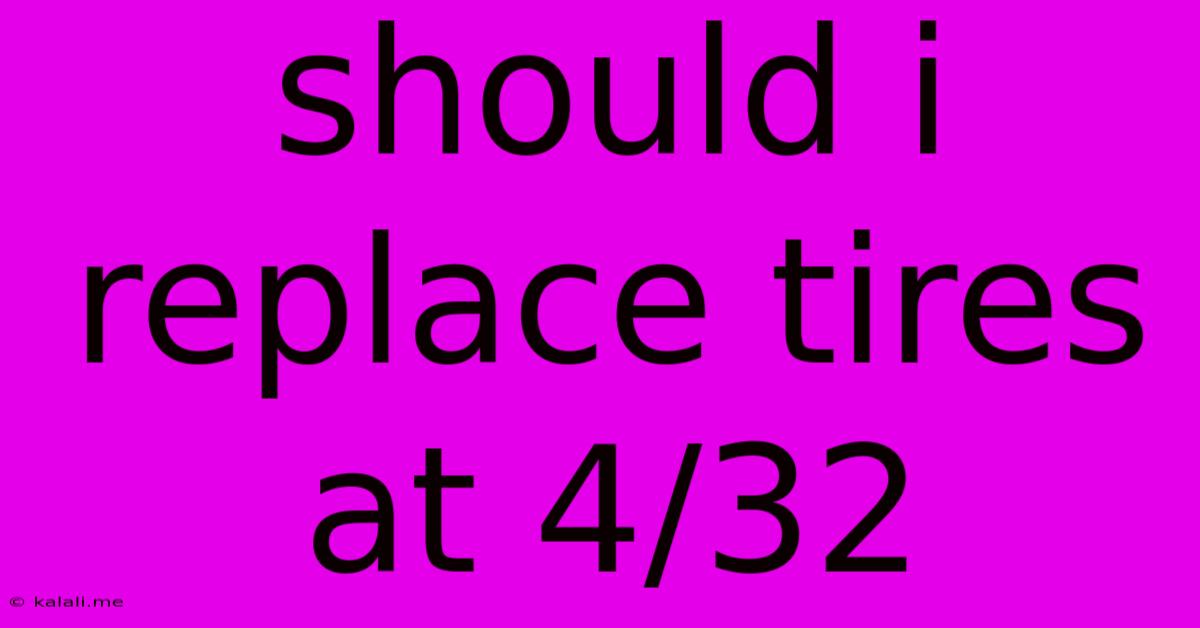Should I Replace Tires At 4/32
Kalali
Jun 02, 2025 · 3 min read

Table of Contents
Should I Replace Tires at 4/32"? A Comprehensive Guide to Tire Tread Depth
Your car's tires are the only contact point between you and the road. Maintaining optimal tire tread depth is crucial for safety, handling, and fuel efficiency. But when is the right time to replace them? Many drivers wonder if 4/32" of tread depth is the magic number. This article will delve into the complexities of tire tread depth, helping you determine if replacing your tires at 4/32" is the right decision for you.
Understanding Tire Tread Depth and Wear Indicators
Tire tread depth is measured in 32nds of an inch. New tires typically have a tread depth of 10/32" to 11/32". As you drive, the tread gradually wears down. Most tires have built-in wear bars, small raised strips of rubber across the tread. When these wear bars are flush with the rest of the tire surface, your tread depth has reached the legal minimum. In many places, this minimum is 2/32". However, driving with tires at 2/32" is extremely risky.
The 4/32" Tread Depth Dilemma: Is it Time for New Tires?
While 4/32" of tread is above the legal minimum, it's significantly worn. This raises questions about whether or not it's time for a replacement. The answer isn't a simple yes or no, and depends on several factors:
-
Weather Conditions: Driving in wet or snowy conditions with tires at 4/32" significantly increases your risk of hydroplaning and loss of control. The reduced tread depth compromises grip and braking distance. In such conditions, replacing them is highly recommended.
-
Driving Habits: Aggressive driving, frequent hard braking, and cornering put extra stress on your tires. If you're a spirited driver, you should consider replacing your tires earlier, even before reaching 4/32".
-
Tire Age: Even if the tread depth is above 4/32", older tires can become brittle and prone to cracking, regardless of tread depth. Tire age significantly impacts performance and safety. Check the sidewall of your tires for the manufacturing date. Most tire manufacturers recommend replacing tires after 6 years, irrespective of tread depth.
-
Tire Type: Performance tires, all-season tires, and winter tires have different tread patterns and wear characteristics. Performance tires often wear faster due to their softer compound designed for better grip.
-
Vehicle Type: The weight of your vehicle also impacts tire wear. Heavier vehicles tend to wear tires down faster.
Beyond Tread Depth: Other Factors to Consider
While tread depth is a crucial indicator, it isn't the only factor to consider. Inspect your tires regularly for:
- Uneven Wear: Uneven wear patterns can indicate issues with your vehicle's alignment, suspension, or tire pressure.
- Bulges or Bumps: These indicate potential structural damage and should be addressed immediately.
- Cuts or Cracks: These compromise tire integrity and may lead to blowouts.
When to Prioritize Safety and Replace Your Tires
If you're even slightly hesitant about your tires' condition at 4/32", it's best to err on the side of caution. Replacing your tires before they become a safety hazard is a worthwhile investment, especially given the critical role tires play in your safety and the safety of others on the road. Consider replacing them if you notice any of the following:
- Reduced traction, especially in wet or snowy conditions.
- Prolonged braking distances.
- A noticeable change in handling.
- Visible damage to the tire sidewall or tread.
- The tires are nearing or exceeding their six-year age recommendation.
Conclusion:
While driving on tires with 4/32" of tread is technically legal in many places, it's not necessarily safe, especially in adverse weather conditions. The decision to replace your tires at this depth involves weighing various factors, including weather, driving habits, tire age, and overall tire condition. Prioritizing safety should always be paramount. If you have any doubts, consult a tire professional for an assessment. They can inspect your tires and provide informed advice on whether replacement is necessary. Don't wait for a blowout to realize you needed new tires. Your safety is worth the investment.
Latest Posts
Latest Posts
-
Adding A Second Ac Unit To House Cost
Jun 04, 2025
-
Davinci Resolve Toggle Node On Off
Jun 04, 2025
-
Denver To Salt Lake City Driving
Jun 04, 2025
-
Can You Use Coconut Oil To Fry
Jun 04, 2025
-
2014 Ford Fusion Radio Wiring Diagram
Jun 04, 2025
Related Post
Thank you for visiting our website which covers about Should I Replace Tires At 4/32 . We hope the information provided has been useful to you. Feel free to contact us if you have any questions or need further assistance. See you next time and don't miss to bookmark.